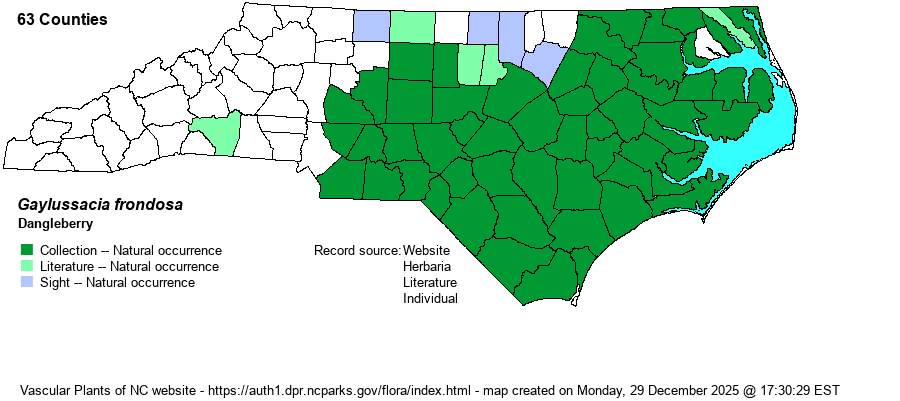| Author | (L.) Torrey & A. Gray ex Torrey | |
| Distribution | Occurs in essentially every county in the Coastal Plain and southeastern Piedmont. Absent from the Mountains and nearly all of the western Piedmont; spotty occurrence in the central Piedmont. Ranges west to Stokes, Rowan, and Union counties.
The species, despite its abundance across the eastern Carolinas, has a fairly narrow east-west range, and seemingly does not even occur in GA. It ranges north in the Coastal Plain and Piedmont regions to much of NY and to NH.
| |
| Abundance | Very common to abundant throughout the Coastal Plain. Frequent in much of the southeastern half of the Piedmont, though more local in northern Piedmont counties, near the VA border. It can occur in very extensive stands, even well into the Piedmont. | |
| Habitat | This species occurs in more mesic and moist sites than does Gaylussacia dumosa, though both can occur together. It favors flatwoods in the Coastal Plain, streamhead pocosin ecotones in the Sandhills, and rather dry forests, in acidic soils. In the Piedmont it occurs in dry upland forests and rocky hilltop woodlands, at times with Gaylussacia baccata (where they can be easily confused). |
| Phenology | Blooms from late March to May; fruits from June to August. | |
| Identification | This is a somewhat low-growing, deciduous shrub that can cover extensive areas in dry or mesic forests. Its typical height is about 2-3 feet tall. Though it has leaves similar in shape to those of G. baccata (i.e., entire and elliptical with a rounded tip), Dangleberry has somewhat glaucous (pale green) leaves that are typically quite pale below. If in doubt, squeeze a leaf between your fingers and note the yellow sticky resin below (but not above), or rub a leaf on a piece of white paper to see the yellow smear from the underside of the leaf. Gaylussacia baccata is glandular/sticky on the both leaf surfaces. The sticky glands on the leaf undersides will separate the species and genus from similar ericads such as Deerberry (Vaccinium stamineum), which do not contain glands on the leaves; most Vacciniums also have leaves with pointed tips. | |
| Taxonomic Comments | It is often considered to have several varieties, and if treated as such, then it is named as G. frondosa var. frondosa. Recent treatments, however, split out former varieties to full species, especially G. tomentosa.
| |
| Other Common Name(s) | Blue Huckleberry is a frequently used name. | |
| State Rank | S5 | |
| Global Rank | G5 | |
| State Status | | |
| US Status | | |
| USACE-agcp | FAC link |
| USACE-emp | FAC link |

